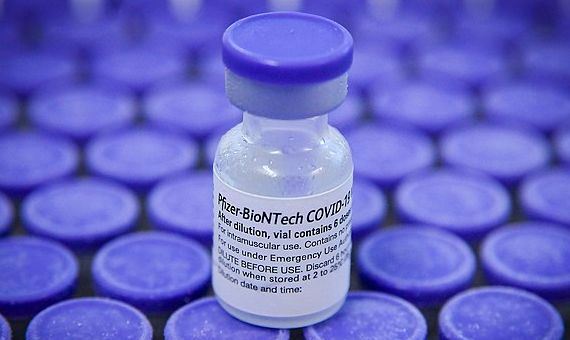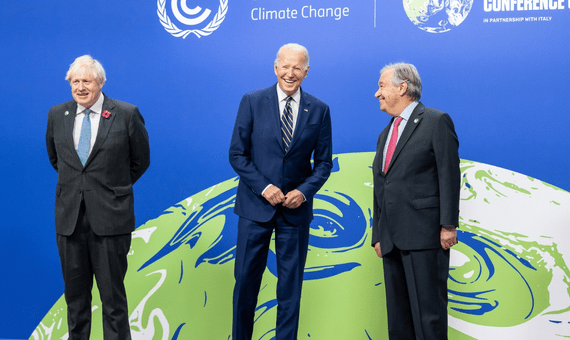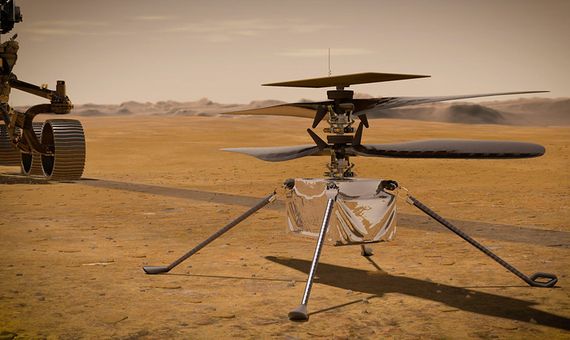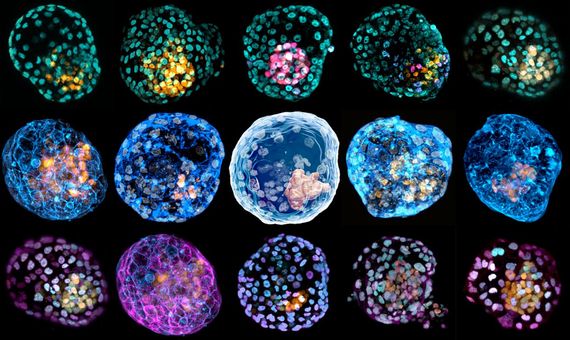As in the previous year, in 2021 the pandemic of the SARS-CoV-2 coronavirus, the cause of COVID-19, continued to dominate the news, and thus also focused the spotlight on the efforts of the scientific community. However, life and science go on, and the year that is coming to an end has also seen other developments. Some of these are promising and astonishing, such as advances in space exploration or human biology; some are intriguing, such as a finding that contradicts the standard model of physics; and some are disappointing, such as the insufficient commitment in the fight against the climate crisis.
Vaccines make history…
Since January 2020, the COVID-19 pandemic has been reshaping human society in ways we could scarcely have imagined, a challenge to which science has responded with an efficiency and speed that has astonished the world. While 2020 saw the rapid development of the first vaccines against the new coronavirus, it was in 2021 that vaccination campaigns were rolled out and the main winners in the race against the virus emerged: RNA vaccines, developed by Pfizer-BioNTech and Moderna-NIH, have been shown to offer strong and consistent protection against the most severe symptoms and mortality. There are indications that the level of neutralising antibodies may decline over months, although the effect on protection remains to be determined. In any case, booster shots appear to provide people with sufficient immunity. However, there is still concern about the low level of access to vaccines in much of the developing world.

…But the virus finds its way in
Thousands of variations in the genome have been found in the sequencing of the circulating SARS-CoV-2 virus, but over the course of 2021 certain variants have successively spread, characterised as either of concern or of interest. Among those of interest are Lambda and Mu, while the variants of concern include Alpha, Beta, Gamma, Delta and Omicron. Delta became so widespread that it almost completely replaced earlier lineages. And while current data support its increased infectivity and severity of symptoms, it does not appear to escape the reach of the vaccines. However, the more recent Omicron variant, which has accumulated 50 or so mutations, has sparked a wave of panic because of its ease of transmission, the possibility of reinfection and of lower vaccine efficacy, although its symptoms may be milder. Fortunately, RNA vaccines can be rapidly updated to respond to new variants.
A lukewarm climate summit
From 31 October to 12 November, the 26th United Nations Climate Change Conference, or COP26, was held in Glasgow (UK). The meeting was an important juncture in terms of deepening the commitment of countries to meet the goals set in 2015 by the Paris agreement to limit the rise in global temperature to below 2 °C. However, experts expressed doubts about the commitments to be made by nations. At the end of COP26, there were mixed reactions, but generally unfavourable assessments, with youth leader Greta Thunberg summing up the outcome as follows: “Blah, blah, blah.” The deal calls for further emission reductions—45% by 2030 compared to 2010—progress monitoring and support for developing countries, but more ambitious pledges are missing, as current commitments will result in a 2.4°C increase. Meanwhile, the Intergovernmental Panel on Climate Change (IPCC), ahead of its forthcoming sixth assessment report, warned that the planet is facing more frequent extreme weather events.

The unknown origin of the virus
It is an issue that periodically attracts media and public attention, only to be all but forgotten, and it is also one of the biggest sources of speculation surrounding the pandemic, from expert reflection and analysis to conspiracy theories: how did the SARS-CoV-2 coronavirus emerge? As of 2021, a definitive answer has not been found, and may still be delayed or never come. In March, the World Health Organisation (WHO) published the report of its mission to China to analyse the available data on the origin of the virus, without any major conclusions, but suggesting a greater likelihood of a natural origin than the possibility that it escaped from a laboratory in Wuhan. Subsequently, new studies have revived the hypothesis that the market in that Chinese city was the initial focus of the infection. Research continues, as the findings may be crucial in preventing future pandemics.
To Mars by land, air and space
On 18 February, NASA’s Perseverance rover touched down on Mars, adding another milestone to the already long list of missions by the US space agency that have tackled the exploration of the red planet. On this occasion there is an absolutely new addition that has made headlines and captured the public’s interest: the mission includes a small helicopter called Ingenuity that for the first time has flown above the soil of another world, offering a never-before-seen perspective of the Martian landscape. But in 2021, NASA’s hegemony over the Martian surface has also been broken. On 15 May, the Chinese rover Zhurong, part of the Tianwen-1 mission, gave China the honour of being the second space power with an operational presence on the surface of Mars. In another historic milestone, the United Arab Emirates successfully placed its Hope spacecraft into Martian orbit.

Proteins reveal their secrets
One of the major goals of biology over the last half-century has been to find as standardised a way as possible to predict the three-dimensional structure of proteins. These molecules composed of chains of different amino acids carry in their sequence the information that will determine their spatial folding, but so vast and complex is the interaction between the different chemical groups and their charges that until now the 3D structure of each protein was a specific problem to which one or several doctoral theses could be devoted. Today, perhaps no longer: in our 2020 science round-up we reported on an Artificial Intelligence algorithm called AlphaFold developed by Google’s DeepMind that was able to predict the 3D structure of any protein. This year, DeepMind has made good on its promise, publishing the structures of more than 350,000 proteins from humans and other organisms, which the company plans to soon expand to more than 100 million. This is a breakthrough of enormous significance with applications in the design of drugs against countless diseases.
Muons defy the standard model
In physics, discrepancies between theoretical models and experimental results are rare, but when they do occur they often open the door to new physics. For the last half century, the so-called Standard Model of particle physics, based on the 17 elementary particles and the four forces that govern the quantum world, has prevailed. And although there are questions that the model has not yet been able to answer, its predictions have been consistently verified, including the Higgs boson. However, a couple of decades ago, results from the Brookhaven National Laboratory found a value for the magnetism of the muon—a particle with the same charge as the electron, but higher mass—that disagreed with the theory. On 7 April, scientists working on the Muon g–2 (pronounced gee minus two) experiment at Fermilab in Chicago corroborated this finding: the muon is more magnetic than it should be according to the standard model. The anomaly is small, 2.5 parts in one billion, but if it is confirmed, physicists will have to find a way to explain it.
Laboratory embryos
Stem cells are a promising area of biomedicine—especially regenerative medicine—that is already yielding breakthroughs in the experimental field, but has yet to unleash its potential on a large scale. In recent decades, research has advanced along two related lines: the use of embryos to obtain stem cells capable of generating any tissue, and the reprogramming of adult cells to obtain from them cells with embryonic-like capacities (called induced pluripotent stem cells, iPSCs). This second procedure avoids the controversial use of embryos, but does not offer the same versatility they provide. However, this barrier is being overcome: this year, various research groups have succeeded in obtaining blastoids, structures very similar to blastocysts—mammal embryos in their earliest stage of development—from iPSCs. The breakthrough is of enormous importance for studies of embryonic development and its anomalies, as well as driving the development of organoids, tiny simulations of organs that hold great promise in the testing of new drugs.

Touching the Sun
On 14 December, scientists from NASA’s Parker Solar Probe mission announced and published a paper about the conquest of a new frontier by humans: the Sun’s atmosphere. The probe was launched in 2018 with the aim of studying solar magnetism, the Sun’s emission and the extreme heating of its corona, but its journey also involved achieving two records: the fastest spacecraft speed in history and the closest approach to the Sun. As the researchers revealed this December—after taking time to verify the data—on 28 April the probe crossed the so-called Alfvén critical surface, the boundary where the Sun’s atmosphere ends and the solar wind begins, located 18.8 solar radii from the surface, or some 13 million kilometres, and then came within 15 solar radii. In its future orbits, it will continue to fly even nearer, to within 9 solar radii, giving scientists a closer look at our star than ever before.
Hubble’s successor
While it appears in tenth place on this list, this is not because it is of relatively minor importance; in fact, it promises to be as powerful a tool for space exploration as the Hubble Space Telescope has been since 1990. But we cannot yet take it for granted, since at the time of writing it has not yet happened: the new James Webb Space Telescope (JWST), developed by NASA, the European Space Agency (ESA) and the Canadian Space Agency (CSA), is scheduled for a Christmas launch on 24 December aboard an Ariane rocket from French Guiana. With a mirror diameter almost three times that of Hubble, and its increased sensitivity in the infrared band, JWST will offer a window onto the universe’s first galaxies and potentially habitable exoplanets that were beyond the gaze of its predecessor. If all goes according to plan, one of JWST’s discoveries will surely merit a place on this list in 12 months’ time.
Comments on this publication